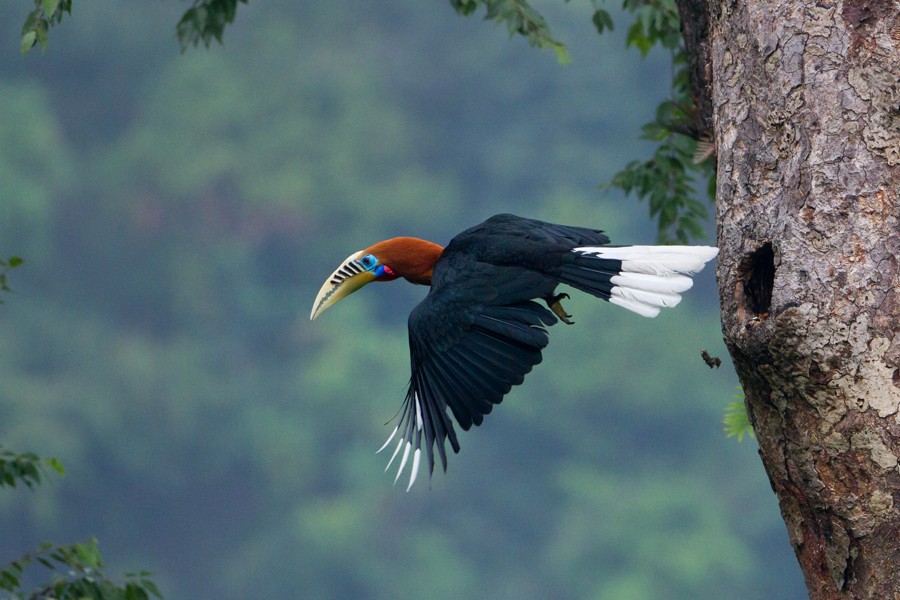Rufous-necked Hornbill
A species of Rufous-necked Hornbill Scientific name : Aceros nipalensis Genus : Rufous-necked Hornbill
Rufous-necked Hornbill, A species of Rufous-necked Hornbill
Botanical name: Aceros nipalensis
Genus: Rufous-necked Hornbill
Content
Description General Info
 Photo By Ujjal Ghosh , used under CC-BY-SA-3.0 /Cropped and compressed from original
Photo By Ujjal Ghosh , used under CC-BY-SA-3.0 /Cropped and compressed from original Description
The head, neck, and lower body of the male are coloured rufous, with deeper colouration on the flanks and abdomen. The middle primaries and the lower half of the tail are tipped white. The rest of the hornbill's plumage is a glossy dark-green and black. The lower tail-covert feathers are coloured chestnut mixed with black. The female, on the other hand, is black, except for the end-portion of her tail and the tips of the middle primaries, which are white. Juvenile hornbills resemble adults of the same sex, but lack the ridges at the base of the upper beak. The beak lacks a true caique but is thickened at its base. It has a number of dark ridges on the upper beak which are absent in the young and increase in number with age up to about seven. The commissure of the beaks is broken for both sexes. 
Size
1 m
Nest Placement
Tree
Feeding Habits
Rufous-necked Hornbill predominantly dines on fruits like figs and mangoes. During breeding, they consume Dysoxylum. These birds forage in the canopy, sometimes ground-feeding on fallen fruit. Rufous-necked Hornbill forage in pairs or small groups and congregate in larger numbers at roosts.
Habitat
The habitat of rufous-necked Hornbill primarily consists of dense evergreen and deciduous forests found in hilly and mountainous regions. These forests are typically positioned along ridges, where rufous-necked Hornbill nests and forages. The bird favors areas where these types of forests are prevalent, emphasizing the necessity for forested landscapes in its ecology.
Dite type
Frugivorous
General Info
Feeding Habits
Bird food type

Fruit
Distribution Area
Of all hornbills, this species has the northernmost extent, ranging from central Bhutan and north-eastern India to western Thailand and north-western Vietnam. In India, the hornbill has been recorded from the following protected areas: Namdapha National Park, Arunachal Pradesh. Manas National Park, Assam. Buxa Tiger Reserve, West Bengal. Mahananda Wildlife Sanctuary, West Bengal. Eaglenest Wildlife Sanctuary, Arunachal Pradesh. Kamlang Wildlife Sanctuary, Arunachal Pradesh. Sessa Orchid Sanctuary, Arunachal Pradesh. Pakke Tiger Reserve, Arunachal Pradesh. The western limit of the rufous-necked hornbill is the Mahananda Wildlife Sanctuary in West Bengal. Kinnaird and O'Brien (2007) have tabulated data for the hornbills of the world and report that rufous-necked hornbills range over 1,163,811 km (449,350 sq mi) of area, of which 825,837 km (318,857 sq mi) of area are forested. Within this area, rufous-necked hornbills occur in 90 protected areas comprising 54,955 km (21,218 sq mi) of protected forest but only including 7% of optimal hornbill habitat. 
Species Status
Already listed in CITES Appendices I & II, the species is vulnerable but occurs in a number of protected areas in India, China, Thailand and Bhutan. Due to increased information coming in about range and extent, it has been suggested that the rufous-necked hornbill be downgraded from IUCN status "Vulnerable" to "Near Threatened". Recent initiatives by the Wildlife Trust of India, Arunachal Pradesh Forest Department and other citizens to conserve hornbills, which also target the rufous-necked hornbill, are the Hornbill Nest Adoption Programme, and a programme for replacing the use of real beaks with fibre-made replicas. . 
Scientific Classification
Phylum
Chordates Class
Birds Family
Hornbills Genus
Rufous-necked Hornbill Species
Rufous-necked Hornbill